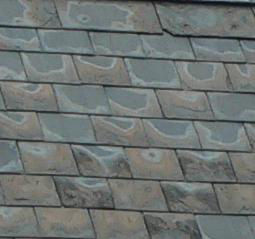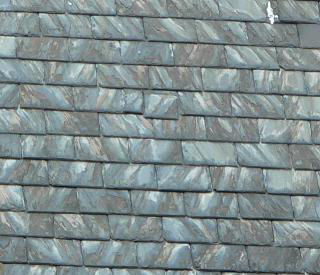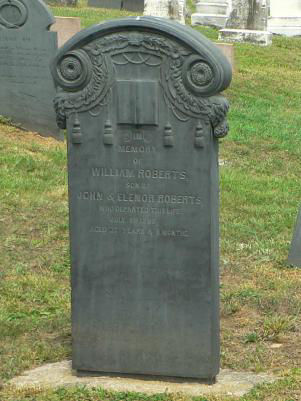

Slate Roofs Continued (See Part 1)
By Bill Kibbel
Life Expectancy
While the type and frequency of maintenance significantly influences the service life of a slate roof, the quality of the slate is also a factor. That quality is determined by exactly where the slate was extracted from the earth. It also determines the color and if it will change when exposed to weather. I'll try to describe the variations in the different types of slate without getting all petrographical, but differences are mostly due to the varying mineralogical and chemical contents in the sediments which eventually metamorphosed into slate.
Slate quarried specifically for roofing in the US came mainly from quarries that were established along the Appalachian mountains in the Northeast and a bit south. Each of the areas of quarries in each state produced different types, colors and qualities of slate. The quality and color could also vary to some degree in the same quarry. Slates that last a very long time are often referred to as hard and those with the shortest life are considered a soft slate. The word soft isn't usually used when describing rock, but comparing hard and soft slates, there's a considerable difference.
Maine
Commercial roofing slate mostly came from the slate belt in the center of the state. Often called Monson slate, from the town and quarry name of the first and oldest in the state.
It's mostly a very hard, durable black slate (very dark gray) with slight purple hue in direct sun. Predicted life is 200 to several hundred years.
Vermont/New York
Slate Valley extends along the VT/NY border through Rutland County, VT and Washington County, NY. This narrow 30 mile long valley is the only area where commercial produced slate of many shades of several colors has been found. These include purple, green, gray, black, bluish green, mottled/variegated (purple and green) and red – the last being only on the New York side.

The green, purple and red are from varying amounts of hematite and chlorite contained in the deposits that metamorphosed into slate.
Most slate from this area is very hard and durable. Slate used for roofing from this region is expected to last between 150 and 250 years, with the exception of a small amount of sea-green slate that is beginning to soften at 125 years.
Pennsylvania – Soft Vein
A majority of roofing slate during peak production was from PA. For example, in 1900, Pennsylvania slate production was more than twice as much as all other major slate producing states combined. Most slate in PA was from the slate belt that extends across Northampton and Lehigh Counties, on the south side of the Blue Mountains. Most of the quarries in this area produce “soft” slate. If you've seen a real slate blackboard, its probably from here.
The slate from this region is various shades of black, gray and blue-black. It is usually quite smooth on the split surfaces, but quite dull (no sheen). Most of it changes after being exposed to weather for many decades. This is often called fading or weathering. Much of the slates from the Bangor quarries gets quite lighter around the exposed trimmed-edges and gradually continues to the center. Some folks say this resembles an old man growing a light-gray beard. This lightening is from calcium sulfate (gypsum) effloresce (migrated to the surface). Slates further west, from the Pen Argyl area start out gray, but weather to reddish brown on the surface. This is from sulfides of iron decomposing and oxidizing.

These soft vein slates with mineral impurities begin flaking on the surface (scaling) typically when getting toward the last couple decades of their service life. If installed on spaced strips of wood above an unfinished attic, you can also find powdering on the underside of the slates. Another issue was the use of ribbon slate from this area for roofing. These slates have a band of material laid in the sediment that is softer and contains more calcite, iron or carbonaceous material. If the bands are below the nails securing each slate, they can break off. The end-of-life for these soft-vein slate roofs is often between 70-110 years.
Chapman
In the southern section of the slate belt, there are two areas that produced hard slate; Belfast and Chapman. Chapman Quarries also produced a very popular and unique slate. Somewhat like ribbon slate, there were layers of sediment of different compositions resulting in dark gray slates with darker bands. Unlike ribbon slate, these striations are mostly quite hard, durable and can have a life of 110-160 years.

Peach Bottom
Quarries in this area are located at the southern border of Pennsylvania and extend into Maryland. The Peach Bottom slate district is in southern York and Lancaster counties in PA and Harford County, MD. It is the location of the first commercial slate quarry in the US and home to what many have considered the best slate in the world.
This black slate is very fine-grained and hard. It seems to have a sheen to the surface as compared to other black slate. It is usually split very thin, which would be an issue for most other slates that are not as strong. Unlike the soft PA slate, it has some texture to the split face.

Peach Bottom slate is extremely durable with a life that can probably be measured in many hundreds of years. A testament to how well it weathers is the condition of the slate gravestones in the region. The lettering and other carving is still sharp-edged and clear on stones carved over 150 years ago.
Virginia
Usually referred to as Buckingham Slate today, Virginia slate is quarried in the Arvonia District located in Buckingham and Fluvania Counties.
This black slate is also a very hard and durable, similar to Peach Bottom. The surface of the split face is also textured. This slate has a sheen, but also sparkles in direct light. This slate has an expected service life of 200-300 years, maybe more.
Predictions
The the life expediencies are estimates and there are other factors that can contribute to shortening the life of the roof including improper installation details, amateur maintenance and repairs, roof slope, severe weather, slate roof knowledge and appreciation. Unfortunately many of those items result in slate roofs being prematurely replaced with an inferior product.
Resources
Slate Roofing Contractors Association of North America Member List: slateroofers.org/directory.html
Slate Roof Publications: slateassociation.org/resources
Traditional Roofing Magazine Articles: traditionalroofing.com
History and Heritage
National Slate Museum in Llanberis, Gwynedd, Wales: museum.wales/slate
Slate Valley Museum in Granville, NY: slatevalleymuseum.org
Slate Belt Museum in Mt. Bethel, PA: slatebeltmuseum.org
Slate Belt Heritage Center in Bangor, PA: slatebeltheritage.net
Delta Slate Tour with Jones Geological Services: ricksweb.yourwebhosting.com/Jeri/slate.htm
Old Line Museum in Delta, PA: oldlinemuseum.com

Bill Kibbel is a consultant and an inspector of historic homes
& commercial buildings at Heritage Building Inspections.
Designed with Mobirise web theme